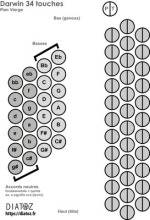Siegmund
Well-known member
I feel like I remember reading about somebody's system where the chord buttons played 2 notes rather than three, with the idea that this made it much easier to play the jazzy 7th and 9th chords (getting C-E-G-B from the adjacent C-E and G-B buttons, rather than a big stretch to press C major and E minor at the same time, for instance.)
I went looking for a diagram of it, and I can't find it. (Presumably the major and minor rows just become major and minor thirds, but what do the other two rows do.)
And I was under the (mis)impression that this was called a Moschino system, but all the references I can find to Moschino are to a nonstandard layout for single note free bass.
Can anybody tell me what this was called, or point me to a link to it? (Or did I just imagine the whole thing? I would swear I read about it on this forum maybe 2 years ago.)
I went looking for a diagram of it, and I can't find it. (Presumably the major and minor rows just become major and minor thirds, but what do the other two rows do.)
And I was under the (mis)impression that this was called a Moschino system, but all the references I can find to Moschino are to a nonstandard layout for single note free bass.
Can anybody tell me what this was called, or point me to a link to it? (Or did I just imagine the whole thing? I would swear I read about it on this forum maybe 2 years ago.)

